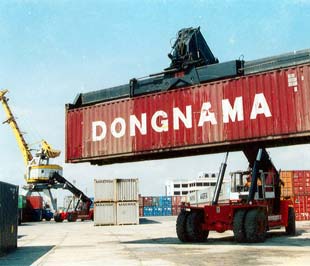INDOCHINA INTERNATIONAL CONSULTING CO., LTD
HO Add: 62L/36 Nguyên Hồng, Ward 11, Bình Thạnh District, HCMC - Vietnam
Biz Office Add: #48 Road No 11, Quarter 6, Hiệp Binh Chánh Ward, Thủ Đức, HCMC - Vietnam
®Source: http://viipip.com should be clearly quoted for any use of information extracted from our website.
Publication permit No: 60/GP-TTĐT , April 05, 2010.


Vietnam’s exports have shown signs of decrease as a result of the world’s financial crisis The Ministry of Industry and Trade (MOIT) has predicted that if the current situation continues, Vietnam’s export turnover in the last two months of the year will only reach $9.4 billion ($4.7 billion a month), which is down by 1.3% when compared to the same period of 2007. If this happens, the total export turnover for 2008 will be $62.8 billion. The important thing that businesses need to focus on right now is finding the key to the various markets in the world.
The Ministry of Industry and Trade (MOIT) has predicted that if the current situation continues, Vietnam’s export turnover in the last two months of the year will only reach $9.4 billion ($4.7 billion a month), which is down by 1.3% when compared to the same period of 2007.
If this happens, the total export turnover for 2008 will be $62.8 billion. The important thing that businesses need to focus on right now is finding the key to the various markets in the world.
A mountain of difficulties
Narrowed export markets and decreasing prices are the biggest problems currently facing Vietnamese exporters. The export turnover in October dropped more sharply than expected. At first, officials predicted a slight decrease in October’s exports in comparison with the average monthly export turnover in previous months: $5.1 billion vs. $5.7billion. However, the export turnover in October sharply decreased to $4.7 billion, which was $400 million lower than expected and $700 million lower than the previous month.
Blame for the decrease in export turnover last month has been placed on smaller exports of rice and rubber, as well as the lower export prices in October in comparison to September. The crude oil price, which began decreasing in September, continued sliding in October. The current oil price is equal to half of the price three months ago. The rice price has also dropped by 20% when compared to September.
The prices of key export items all have decreased: crude oil price by 4%, rubber price by 13.2%, and coffee by 11.7%. However, the price of some farm produce items have increased, including pepper by $148/ton, cinnamon by $240/ton, and tea by $72/ton. Nonetheless, the export volume of the price-increasing items was not high enough to help raise the export turnover .
ADB’s Vietnam Country Director, Ayumi Konishi, said at ACMECS, which was held in
Experts have warned that Vietnamese businesses will have to compete with formidable rivals, including
They have pointed out that the biggest problem that currently threatens
The ways out still exist
Despite these difficulties, experts still believe that
Former Minister of Trade, Truong Dinh Tuyen, has pointed out that there are still existing opportunities for Vietnamese enterprises to boost exports, since the majority of
In theory, when the economic recession occurs, the demand for low-cost products, as alternatives to luxury ones, will increase.
Tuyen believes that
It is undeniable that Vietnamese enterprises are facing major difficulties as their main export markets, the US and
Vietnam’s exports to Asian markets in the first 10 months of the year reached $26.5 billion, up by 47% over the same period of the last year, while the exports to Oceania were $4 billion, up by 62%, and exports to Africa were $1.05 billion (+ 75%).
- FDI capital continues to pour into Vietnam (6/11/2025 1:20:33 PM)
- Thanh Hoa receives good news: Preparing to have an additional industrial park of up to 470 hectares, creating jobs for nearly 30,000 people (6/11/2025 1:15:09 PM)
- Industrial Park Real Estate: Waiting for the New Generation of FDI (6/11/2025 1:10:15 PM)
- A wealthy Vietnamese city will have two special economic zones after the merger (6/11/2025 1:04:42 PM)
- 30 billion USD capital FDI in Việt Nam by 2025, a series of "ông big" races to expand the land fund (6/11/2025 12:55:26 PM)
- the 2nd largest city in the North will start construction on an international economic zone (6/11/2025 12:50:20 PM)
- Japanese giant Sumitomo continues to want to build an industrial park in the countrys fourth smallest province. (6/11/2025 12:40:45 PM)
- 3 foreign corporations want to invest billions of dollars in Ba Ria - Vung Tau (6/11/2025 12:34:30 PM)
- Lotte Group member starts construction of nearly 1,000 billion VND logistics center in the province with the most industrial parks in Vietnam (6/11/2025 12:33:26 PM)
- Forming a regional center for manufacturing spare parts and components (6/11/2025 12:24:08 PM)
- Vietnams first wafer factory is about to start construction (6/11/2025 12:19:09 PM)
- Dong Nai attracts foreign investors (6/11/2025 12:13:27 PM)
- Tay Ninhs largest industrial park welcomes a $150 million high-end knitted fabric factory project (6/11/2025 12:11:00 PM)
- (6/11/2025 12:09:10 PM)
- Vietnam will become a destination for Chinese investors in the future (11/6/2023 1:03:19 PM)

- FDI capital continues to pour into Vietnam
- Thanh Hoa receives good news: Preparing to have an additional industrial park of up to 470 hectares, creating jobs for nearly 30,000 people
- Industrial Park Real Estate: Waiting for the New Generation of FDI
- A wealthy Vietnamese city will have two special economic zones after the merger
- 30 billion USD capital FDI in Việt Nam by 2025, a series of "ông big" races to expand the land fund










 ADB: Vietnam’s 2009 GDP growth to be highest in South East Asia
ADB: Vietnam’s 2009 GDP growth to be highest in South East Asia MGM Grand Ho Tram: Vietnam’s First ‘Las Vegas Style’ Integrated Resort
MGM Grand Ho Tram: Vietnam’s First ‘Las Vegas Style’ Integrated Resort Nha Trang’s Twin Towers project licenced
Nha Trang’s Twin Towers project licenced Foreign investors still have good opportunities in Vietnam
Foreign investors still have good opportunities in Vietnam Sierra Wireless gets a foot in Vietnam’s ICT market
Sierra Wireless gets a foot in Vietnam’s ICT market